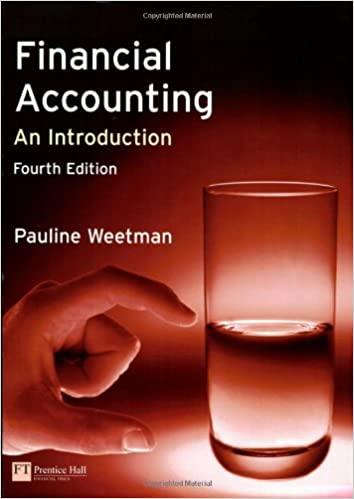Question
EX8 1. The size of the divergence between FIFO cost of goods sold and replacement cost of goods sold depends on the rapidity of the
EX8
1. The size of the divergence between FIFO cost of goods sold and replacement cost of goods sold depends on the rapidity of the inventory turnover and the:
A. change in accounts receivable turnover.
B. divergence of total asset turnover from previous periods.
C. severity of input cost change.
D. rapidity of fixed asset turnover.
2.The major issue in inventory accounting is:
A. determining whether to take inventory using cycle counts as opposed to counting all inventory only at the end of the year.
B. deciding whether to maintain records on a periodic or perpetual basis.
C. determining what goods to include in inventory.
D. choosing the method for allocating goods available for sale to ending inventory and cost of goods sold.
4.LIFOs tax advantage is that it provides a:
A. higher net income than FIFO during periods of rising prices and nondecreasing inventory quantities.
B. lower net income than FIFO during periods of rising prices and nondecreasing inventory quantities.
C. lower net income than FIFO during periods of falling prices and nondecreasing inventory quantities.
D. lower net income than FIFO during periods of rising prices and decreasing inventory quantities.
5. ITEM COST REPLACEMENT COST SELLING PRICE COST OF COMPLETION NORMAL PROFIT
l-19 $40 $38 $50 $2 $11
m-23 $52 $40 $60 $4 $14
n-05 $20 $24 $30 $2 $6
The lower of cost or market for product N-05 is:
A. $20.
B. $22.
C. $24.
D. $28.
6.The inventory accounts of a manufacturer would include all of the following accounts EXCEPT __________ inventory.
A. raw materials
B. work-in-process
C. finished goods
D. sold goods awaiting shipment
7. Current ratio distortion under LIFO inventory costing may be adjusted by:
A. adding the LIFO reserve to current assets.
B. subtracting the LIFO reserve from current assets.
C. adding the LIFO reserve to current liabilities.
D. subtracting the LIFO reserve from current liabilities.
8.MARCH 1 INVENTORY BALLANCE 400 UNITS @ $3.10
5 PURCHASE 1,400 UNITS @ $3.20
14 PURCHASE 280 UNITS @ $3.25
31 INVENTORY BALANCE 520 UNITS
In a periodic inventory system, the ending LIFO inventory is:
A. $1,624.
B. $1,655.
C. $1,678.
D. $1,733.
9. TAD, Inc. uses the lower-of-cost-or-market method to value inventory. If the inventory value is replacement cost, which one of the following statements is true?
A. Historical cost is less than replacement cost.
B. Replacement cost is greater than net realizable value less a normal profit margin.
C. Replacement cost is greater than historical cost.
D. Net realizable value is greater than historical cost.
10. Analysts must be aware that with the use of absorption costing, as inventory absorbs more fixed costs, reported net income tends to:
A. increase.
B. decrease.
C. remain the same.
D. become highly volatile.
11. MARCH 1 INVENTORY BALLANCE 400 UNITS @ $3.10
5 PURCHASE 1,400 UNITS @ $3.20
14 PURCHASE 280 UNITS @ $3.25
31 INVENTORY BALANCE 520 UNITS
In a periodic inventory system, the FIFO cost of goods sold is:
A. $4,952.
B. $4,967.
C. $4,993.
D. $5,006.
14. The Johnson Corporation reported at the end of the year a LIFO reserve of $45,000. The beginning LIFO reserve was $60,000. The cost of goods sold was $260,000 under LIFO. The cost of goods sold under FIFO should be:
A. $245,000.
B. $260,000.
C. $275,000.
D. $305,000.
15.The mechanics of absorption costing can lead to year-to-year income changes:
A. whenever inventory levels remain fairly constant.
B. if the productivity of factory workers improves.
C. whenever production and sales are not parallel.
D. when raw material prices are increasing.
16. For a firm using LIFO, the numerator of the inventory turnover ratio is predominantly current period costs:
A. and the denominator consists of old LIFO costs.
B. thus it must be adjusted to conform to the old LIFO costs in the denominator.
C. thus the denominator must be adjusted by adding the LIFO reserve to ending inventory.
D. thus the denominator must be adjusted by subtracting the LIFO reserve from both beginning and ending inventory.
17. Goods available for sale need to be allocated between:
A. beginning inventory and inventory purchases.
B. beginning inventory and ending inventory.
C. ending inventory and cost of goods sold.
D. inventory purchases and cost of goods sold.
18. Manufacturing costs NOT considered to be closely associated with production are called __________ costs.
A. period
B. product
C. absorption
D. variable
19. LIFO layers are more likely to be liquidated when inventory records are kept on a/an _____ basis.
A. inventory group
B. total inventory
C. item-by-item
D. specific identification
20.The Skone Corporation reported at the end of the year a LIFO reserve of $25,000. The beginning LIFO reserve was $20,000. The cost of goods sold was $197,500 under LIFO. The cost of goods sold under FIFO should be:
A. $192,500.
B. $197,500.
C. $202,500.
D. $222,500.
Step by Step Solution
There are 3 Steps involved in it
Step: 1

Get Instant Access to Expert-Tailored Solutions
See step-by-step solutions with expert insights and AI powered tools for academic success
Step: 2

Step: 3

Ace Your Homework with AI
Get the answers you need in no time with our AI-driven, step-by-step assistance
Get Started


